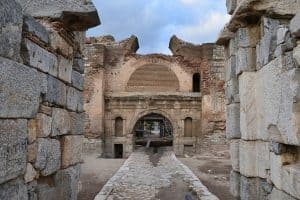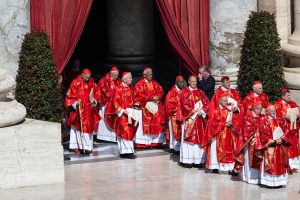By Dr Andy Byers
In the Christian calendar, Easter commemorates the resurrection of Jesus. Though he was crucified, his tomb was found empty on the third day, after which he appeared to many of his disciples. These events are now celebrated annually on Easter Sunday
What does Easter celebrate?
In Christian tradition, Easter affirms that Jesus is alive in bodily form at the right hand of God the Father in the heavenly court. His resurrection from death affirms his divinity alongside his humanity and serves as a reminder that those who follow Jesus will also rise from death into life, both spiritually (in the present) and physically (in the future).
The date varies each year because Easter is pegged to the Jewish festival of Passover, when the Easter story took place. The last supper was the “seder” Passover meal. The date of Passover depends on the lunar cycle and begins on the day with a full moon.
What does the Bible say about it?
The Gospels of Matthew, Mark, Luke, and John say that Jesus was crucified under the authority of Pontius Pilate, the Roman prefect of Judea. Though it is not possible to come to an exact date, the crucifixion occurred c. 30AD.
The four Gospels recount series of events in which Jesus’ tomb is found empty on the first day of the week — Sunday, in the Jewish timing — by women who went to perform burial rites on his corpse. Mary Magdalene is the consistent in all four accounts. Soon after his tomb is found empty, Jesus is recorded as having appeared to individuals and groups among his disciples before his ascension into Heaven, an event narrated at the end of Luke and at the beginning of Acts, the fifth book of the New Testament, which was also written by Luke.
Jesus does not make a post-resurrection appearance in the original ending of the Gospel of Mark (at 16:8); but an angelic figure informs the women who have come to prepare his body that he is waiting for the disciples at a previously agreed rendezvous point in Galilee (14:28).
In the other canonical Gospels, resurrection appearances include Jesus appearing in cognito to two disciples en route to the village of Emmaus (Luke 24:13-35), commissioning his disciples to go into the nations (among the Gentiles, the non-Jews) to baptise and make new disciples (Matthew 28:16-20), and commissioning Peter to serve as a sacrificial caretaker of those who believe in him (John 21:15-22). John and Luke depict Jesus as having meals in front of his disciples, which — at least for Luke — serves as confirmation of Jesus’ physicality. Both Luke and John also portray Jesus as making surprising and unexplainable appearances among the disciples, with John specifically noting that these appearances occurred within rooms with locked doors. Six resurrection appearances are also recounted in 1 Corinthians 15:3-8.
How do we interpret the resurrection?
The idea of a bodily resurrection of the dead was a common belief in early Judaism at the time of Jesus. Resurrection, however, was envisioned not as an event affecting one person only. In spite of the imperial reigns of world powers that dominated their political and cultural life as a people, many Jews in the ancient world held firm to their convictions that their creator God was good, just, and sovereign. These theological ideas in the face of contradictory earthly realities compelled hope that God would surely put an end to this “present evil age” and usher in a “new age” of justice and freedom for his people. The corporate resurrection of those who had died in the present age was understood as a significant component of God’s forthcoming intervention into human history.
This resurrection is prefigured in certain Old Testament texts. Hints that God the creator would destroy the power of death — along with the cosmic and political powers aligned with it — and bring about a new creation for his people appear in Isaiah 24-27 and 65-66. In some Old Testament passages, there are also hints that new creation will entail the resurrection of the deceased faithful (Ezekiel 37:1-14; Daniel 12:1-3, 13).
By the time of Jesus, there were diverse views on this corporate resurrection. Some believed only the righteous would rise again. Others believed both the righteous and the unrighteous would rise and face judgment for their respective deeds. But most believed in a future and corporate resurrection of some kind (a notable exception to this belief are the Sadducees, a powerful Jewish sect associated with the governance of the Jerusalem Temple)
Jesus’ identity and vocation seemed more expansive than the standard expectations associated with the messianic king — his miracles and unique relationship with God puzzled those who encountered him.
What was the significance of the resurrection for early Christians?
The earliest Christians were Jews. When the tomb of Jesus was found empty, it was regarded not only as an indication of his divine and human identity, but also as a clear signal that God’s programme of new creation had in some sense begun and a new age had dawned.
God’s intervention into human history had been under way through Jesus’ earthly ministry and is now evident after his resurrection in the presence of his Holy Spirit in those who believe in Jesus (collectively recognised as the church).
The resurrection is an event Christians participate in spiritually as their old lives rooted in the evil age fades into the past, giving way to a new life risen with Christ. This dying and rising is vividly illustrated in the act of baptism.
For early Christians, Easter celebrates the vindication of Christ who was unjustly executed; affirms his full divinity and full humanity; commemorates the beginning of new creation; and reminds Christians that they are participants in this new creation work as they participate in the resurrected life of Jesus.
How is Easter regarded in the Christian tradition?
The early church was heavily influenced by Jewish ideas of the bodily resurrection, reflected in early creeds.
The Apostles’ Creed is: “I believe in … the resurrection of the body, and the life everlasting.”
The Nicene Creed of 325 includes the line: “On the third day he rose again in accordance with the Scriptures; he ascended into Heaven and is seated at the right hand of the Father.”
In the post-Enlightenment 19th century, theologians began to understand the resurrection as a story with meaning, though not necessarily historical fact. Some suggested that early Christians did not actually encounter the resurrected Christ but underwent some psychological and spiritual experience. Some suggested that what arose on Easter was not the physical body of Jesus but the Christian faith, with the presence of Jesus mediated spiritually and/or psychologically through the proclamation of the Christian message.
In 1984, the Bishop of Durham, David Jenkins, famously said the resurrection “was not just a conjuring trick with bones”.
More recently, Professor N. T. Wright and others have reaffirmed orthodox claims and argued that the accounts of the empty tomb and the visionary experiences point towards the historical reality of the resurrection.
The Rev Dr Andy Byers is a tutor in New Testament at Ridley Hall, Cambridge
Further reading
The Resurrection of the Son of God by N. T. Wright, Professor of divinity, University of St Andrews
Free to Believe, by David Jenkins
The Resurrection of Jesus: A New Historiographical Approach by Michael Licona




















